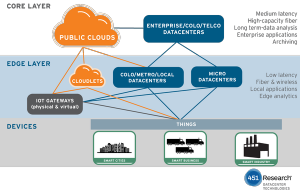Patrick van der Wilt, Commercial Director, EvoSwitch
The logical next step
Edge Analytics – the location of automated, intelligent analytics near where the data is generated — is gaining widespread acceptance as a practical response to the data tsunami forecast from IoT. Data that falls within normal parameters would be ignored or routed to lower cost storage for archival and regulatory reasons, while that which falls outside the norm could trigger an alert and be sent to a primary data platform like EvoSwitch for further analysis. However, logically, service providers and enterprises in many industries will need to go further still, as pointed out in a recent piece by, Rhonda Ascierto and Andy Lawrence of 451 Research.
Extending the edge
In essence, the paper, entitled ‘Datacenters for the Internet of Things: diverse, cloudy and connected’, takes the infrastructure argument and adds a new layer beyond the edge; a distributed network of ‘micro-modular data centers’. These tiny sub-100kW self-contained prefabricated units – aka ‘microsites’ or ‘data centers in a box’ – would be located one step closer to the IoT action, gathering and processing particular latency-sensitive sets of data from sensors and IoT gateways. For manageability, the data would be triggered only if it stands out from the norm, and if every millisecond counts. Not every IoT-enabled business would need this type of coverage, but for some applications – things like latency-sensitive mobile apps, distributed fire detection or vehicle and traffic management – it would be vital.
The graphic below (with thanks to 451) captures the impact on infrastructure neatly:

Early movers
It’s an interesting proposition, and while take-up is not currently widespread, some power operators (Schneider, Emerson) and public cloud providers (think Google ‘fiber huts’) are already moving in this direction. As it begins its journey towards becoming a fully-distributed utility, the most important initial questions will be who is best placed to provide the microsites, how close together will they need to be, and how will they be integrated with existing infrastructure and services? The onus will be on power providers, major public cloud providers, and network service providers to partner up and invest, followed swiftly by the largest and most innovative enterprises and public sector organizations. Does that list include you?
Further Reading
- ‘IoT data analytics spurred on by big data’s expansion interesting short piece on the practicalities of upgrading vehicle data analytics applications. Read article here.


